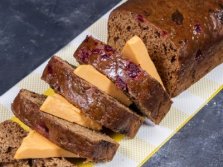
Bun and cheese at Easter is an all-time favourite pastime that has spread across the world … thanks to the strong influence of Jamaican migration. This long-time Jamaican tradition has now become a global trend, with other nationalities embracing yet another part of the culture of the island paradise.
Easter bun comes in different shapes and sizes – round, small, long and fruited – and is often served with a generous helping of cheese. Most persons, including those with diabetes, kidney disease, high blood pressure and obesity, look forward to Easter because of the bun and cheese. It’s the one time of year that bun and cheese is eaten for breakfast, lunch, dinner and snacks … tasty and delicious.
But have you ever stopped to consider how nutritious the bun and cheese sandwich really is?
The main ingredient in the traditional bun is enriched flour and is classified in the staples group in the Caribbean food groups. Bun provides mainly carbohydrates, but over the years, with a wave of health consciousness, buns are now being made with wholewheat flour and bran.
Let’s look at the flour used in bun making:
- White flour is bleached or is refined and does not provide fibre, which is needed to provide that feeling of fullness (satiety) and cause us to eat less.
- Wholewheat flour provides up to one gram of fibre per slice, and this is only if 100 per cent whole-wheat flour is used.
Bran provides less than one gram of fibre per slice.The wholewheat and bran is usually mixed with white enriched flour for it to hold or come together during kneading or mixing, hence the insignificant amount of fibre present. The recommendation for fibre is 25 grams per day.
Persons with diabetes and kidney disease should be guided by a registered nutrition professional as to the amount and type of bun to be consumed. With the current drive to reduce sugar consumption, a lot of bakeries are now producing low-sugar buns.
TIPS Here are some tips:
- A person with diabetes whose blood sugar is normal or close to normal is allowed to exchange a slice of bun with one serving of staple at each meal.
One serving of staple is:
- • One slice bread (wholewheat or white)
- • Four ounces yam
- • One slice or peg breadfruit
- • Half cup rice (brown or white or parboiled)
- • One finger banana
- • Half cup porridge (without milk).
- A person with kidney disease on a potassium restriction is NOT allowed to eat bun made with wholewheat or bran or with dried fruits such as raisins, mixed peel or molasses or brown sugar. Potassium in excess may cause irregular heartbeat and result in a heart attack.
- Consuming bun and all foods in the staples group may result in weight gain, as excess glucose is stored as fat.
Cheese is usually eaten with bun and less often with added butter. The traditional, all-time Jamaican favourite cheese is yellow Cheddar. But is this acceptable for all persons?
Persons who want to consume less fat and sodium should choose mozzarella cheese. This is a white, soft cheese made from a combination of non-fat and low-fat milk and with less salt added.
BENEFITS Cheese is a great source of:
- • Calcium
- • Fat
- • Protein
- • High amounts of vitamins A and B-12
- • Zinc
- • Phosphorus
- • Riboflavin
- Cheese made from the milk of 100 per cent grass-fed animals is the highest in nutrients and also contains omega-3 fatty acids and vitamin K-2.
RISKS - Cheese contains lactose, a sugar that can’t be digested by lactose-intolerant people because their bodies lack the enzyme that breaks it down. People with lactose intolerance may be able to tolerate cheeses such as Parmesan, which are very low in lactose.
- One of the main proteins found in milk is casein, which some people are allergic to.
- Cheese is also a calorie-dense food. Depending on the variety of cheese you eat, you’re getting about 100 calories per ounce.
- Cheese is usually loaded with sodium, which makes it easy to overeat and can be an issue for people with high blood pressure.
- Cheese is also high in fat.
This Easter, enjoy bun and cheese at all meals by reducing the intake of staples and meat or protein-rich foods. Be careful not to overdo it, which can lead to weight gain and a spike in blood sugar and blood pressure.
Have a healthy lifestyle and a holy Easter!

